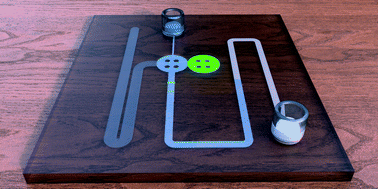NAIL: Nucleic Acid detection using Isotachophoresis and Loop-mediated isothermal amplification†
Abstract
Nucleic acid amplification tests are the gold standard for many infectious disease diagnoses due to high sensitivity and specificity, rapid operation, and low limits of detection. Despite the advantages of nucleic acid amplification tests, they currently offer limited point-of-care (POC) utility due to the need for complex instruments and laborious sample preparation. We report the development of the Nucleic Acid Isotachophoresis LAMP (NAIL) diagnostic device. NAIL uses isotachophoresis (ITP) and loop-mediated isothermal amplification (LAMP) to extract and amplify nucleic acids from complex matrices in less than one hour inside of an integrated chip. ITP is an electrokinetic separation technique that uses an electric field and two buffers to extract and purify nucleic acids in a single step. LAMP amplifies nucleic acids at constant temperature and produces large amounts of DNA that can be easily detected. A mobile phone images the amplification results to eliminate the need for laser fluorescent detection. The device requires minimal user intervention because capillary valves and heated air chambers act as passive valves and pumps for automated fluid actuation. In this paper, we describe NAIL device design and operation, and demonstrate the extraction and detection of pathogenic E. coli O157:H7 cells from whole milk samples. We use the Clinical and Laboratory Standards Institute (CLSI) limit of detection (LoD) definitions that take into account the variance from both positive and negative samples to determine the diagnostic LoD. According to the CLSI definition, the NAIL device has a limit of detection (LoD) of 1000 CFU mL−1 for E. coli cells artificially inoculated into whole milk, which is two orders of magnitude improvement to standard tube-LAMP reactions with diluted milk samples and comparable to lab-based methods. The NAIL device potentially offers significant reductions in the complexity and cost of traditional nucleic acid diagnostics for POC applications.


 Please wait while we load your content...
Please wait while we load your content...